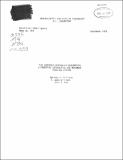The Computer-Controlled Oculometer: A Prototype Interactive Eye Movement Tracking System
Author(s)
Hillsman, Matthew J.; Williams, R. Wade; Roe, John S.
DownloadAIM-253.pdf (6.893Mb)
Additional downloads
Metadata
Show full item recordAbstract
One kind of eye movement tracking device which has great potential is the digital computer-controlled Oculometer, an instrument which non-invasively measures point of regard of the subject, as well as pupil diameter and blink occurrence. In conjunction with a computer-generated display which can change in real time as a function of the subject's eye motions, the computer-controlled Oculometer makes possible a variety of interactive measurement and control systems. Practical applications of such schemes have had to await the development of an instrument design which does not inconvenience the subject, and which conveniently interfaces with a digital computer (see ref. 1). This report describes an Oculometer subsystem and an eye-tracking/control program designed for use with the PDP-6 computer of the MIT Project MAC Artificial Intelligence Group. The oculometer electro-optic subsystem utilizes near-infrared light reflected specularly off the front surface of the subject's cornea and diffusely off the retina, producing a bright pupil with an overriding corneal highlight. An electro-optic scanning aperture vidissector within the unit, driven by a digital eye-tracking algorithm programmed into the PDP-6 computer, detects and tracks the centers of the corneal highlight and the bright pupil to give eve movement measurements. A computer-controlled, moving mirror head motion tracker directly coupled to the vidissector tracker permits the subject reasonable freedom of movement. Various applications of this system, which are suggested by the work reported here, include; (a) using the eye as a control device, (b) recording eye fixation and exploring patterns, (c) game playing, (d) training machines, and (e) psychophysiological testing and recording.
Date issued
1970-09-01Other identifiers
AIM-253
Series/Report no.
AIM-253